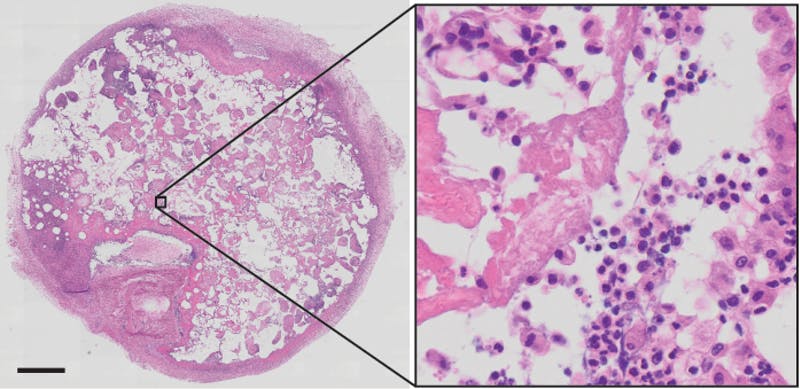
This is a histological section of a retrieved beta cell scaffold stained for cellular structures 14 days after implantation. In the magnified area on the right, the nuclei of trapped autoimmune T cells are showing up as dark dots. (Credit: Wyss Institute at Harvard University)
Early in embryological development, the immune system learns not to attack the body’s own cells. Researchers know that this self-tolerance is ineffective or reversed in more than 80 diverse autoimmune diseases, including type 1 diabetes, multiple sclerosis, and rheumatoid arthritis, partly because of T cells that have gone rogue.
However, with about 1 in 100,000 or fewer of these disease-initiating T cells circulating in the blood, researchers face the challenge of accessing them so they can study their faulty mechanisms.
A team at the Wyss Institute for Biologically Inspired Engineering now reports that by mimicking the insulin-producing environment of the pancreas that is destroyed in type 1 diabetes, they can recruit, isolate and characterize diabetes-causing immune cells in a mouse model of the disease. The team also includes researchers from the Harvard John A. Paulson School of Engineering and Applied Sciences (SEAS) and the Joslin Diabetes Center at Harvard Medical School. Their biomaterials approach, published in the journal Diabetes, could be the basis for similar studies in human patients and also could be used to investigate the causes of other autoimmune diseases.
The relatively ill-understood class of autoimmune T cells that are at the root of type 1 diabetes are mostly found in inaccessible pancreas tissue where they wreak havoc on small islets of insulin-producing beta cells.
“We simulated these inflamed islets of pancreatic beta cells with a biomaterial scaffold right under the skin of mice. By presenting beta cell antigens, we hoped to use the scaffold as an autoimmune T cell ‘trap’, recruiting and capturing the T cells so we could harvest them in vivo,” says Omar Ali, Ph.D., who led the study together with Thomas Serwold, Ph.D.
Ali is a former staff scientist in the Advanced Technology Team at the Wyss Institute and Serwold is an Investigator at the Joslin Diabetes Center’s Section on Immunobiology.
To generate the pancreas-mimicking biomaterial, the researchers infused biological components from a beta cell-derived cell line into a macroporous, biodegradeable scaffold. When implanted under the skin of a diabetic mouse, the ’trap’ recruits autoimmune T cells by inducing them to move through its pores into its interior where they bind self-antigens that are part of the molecular repertoire of the beta cells and expand their numbers. After retrieval of the scaffold, the autoimmune T cells can be easily isolated and further investigated.

This scanning electron microscope image shows the T cell-trapping biomaterial up-close with cavities and ducts allowing the entry, as well as movement and binding of autoimmune T cells in its interior. (Credit: James Weaver)
“Our study provides proof-of-principle that the trapped autoimmune T cells share genetic and functional features with the autoimmune T cells residing in the inflamed pancreas, and that they indeed can promote diabetes when transferred to a mouse that hadn’t developed the disease yet”, adds Ali. The researchers believe that by one day developing analogous injectable scaffold systems for humans that can be easily harvested through needle biopsies they could better understand the disease by analyzing what makes diabetes-causing autoimmune T cells genetically and functionally different from normal T cells.
“Our work’s underlying concept could also give us a handle on autoimmune T cell populations in other diseases and be used as a read-out for the efficacy of drugs that may actually raise immune tolerance in these disorders” saysMooney, Ph.D., who is a co-author on the study, and a Wyss Institute Core Faculty member. Mooney is also the Robert P. Pinkas Family Professor of Bioengineering at SEAS. The idea for autoimmune T cell-trapping biomaterials was inspired by a ‘cancer vaccine’ that was previously engineered by David Mooney’s team at the Wyss Institute and SEAS, which is designed to attract and re-educate immune cells in tumor patients to direct their destructive abilities against tumor tissue.
“The T cell-trapping scaffold technology developed by the Mooney team could advance our understanding of how autoimmune diseases develop, and potentially serve as a companion diagnostic for immune-modulating therapies. It’s also a great example of what is being accomplished by the Wyss Institute’s Immuno-Materials platform,” says Wyss Institute Founding Director Donald Ingber, M.D., Ph.D., who is also the Judah Folkman Professor of Vascular Biology at HMS and the Vascular Biology Program at Boston Children’s Hospital, as well as Professor of Bioengineering at SEAS.




